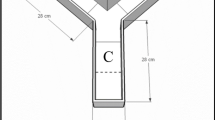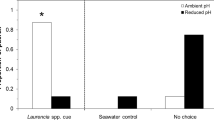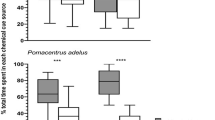Abstract
Sponges are benthic organisms that are dominant in several ecosystems and known to produce a huge chemical diversity. The putative release of some specialized metabolites in the surrounding seawater is still a matter of debate, but the presence of such compounds in the environment of sponges is thought to influence the behaviour of various mobile organisms and may, thus, contribute to benthic ecosystem structuring and functioning. Underwater Mediterranean caves are characterized by stable environmental conditions and sessile species assemblages dominated by sponges. A two-choice test system was developed to assess the response of two cave-dwelling crustaceans (Hemimysis margalefi and Palaemon serratus) and two other species living in shallow water environments (Leptomysis sp. and Palaemon elegans) to various seawater treatments: control− seawater from an exposed coastline, control+ seawater coming from an underwater cave, and seawater conditioned with four Mediterranean sponges commonly found at the entrance of underwater caves (Aplysina cavernicola, Haliclona fulva, Oscarella tuberculata and Spongia officinalis) or their chemical extracts. We tested the swimming behaviour of these crustacean species in three complementary experiments: (1) control seawater vs. cave seawater; (2) control seawater vs. seawater conditioned with the sponge community, (3) control seawater vs. seawater containing chemical extracts of the same sponge community. Both cave-dwelling crustaceans were attracted by the seawater conditioned with the sponge community, while Leptomysis sp. spent more time in the control seawater and P. elegans exhibited indifferent responses. All four crustacean species avoided the seawater containing the sponge extracts. Interestingly, the response shown by the crustaceans was affected by the time of day. A comparative and untargeted metabolomic approach was applied to the surrounding seawater to identify putative chemomarkers that could explain the crustaceans’ behaviours. Among other compounds found in the seawater, a family of metabolites with molecular formulae in accordance with those of oxylipin derivatives is released by sponges and may, therefore, serve as chemical cues acting as kairomones in the homing behaviour of cave-dwelling crustaceans.







Similar content being viewed by others
References
Amsler CD (2008) Algal chemical ecology. Springer, Berlin
Arvedlund M, Nielsen LE (1996) Do the anemonefish Amphiprion ocellaris (Pisces: Pomacentridae) imprint themselves to their host sea anemone Heteractis magnifica (Anthozoa: Actinidae)? Ethology 102:197–211. https://doi.org/10.1111/j.1439-0310.1996.tb01118.x
Arvedlund M, Takemura A (2006) The importance of chemical environmental cues for juvenile Lethrinus nebulosus Forsskal (Lethrinidae, Teleostei) when settling into their first benthic habitat. J Exp Mar Biol Ecol 338:112–122. https://doi.org/10.1016/j.jembe.2006.07.001
Arvedlund M, McCormick MI, Fautin DG, Bildsoe M (1999) Host recognition and possible imprinting in the anemonefish Amphiprion melanopus (Pisces: Pomacentridae). Mar Ecol Prog Ser 188:207–218. https://doi.org/10.3354/meps188207
Atema J, Kingsford MJ, Gerlach G (2002) Larval reef fish could use odour for detection, retention and orientation to reefs. Mar Ecol Prog Ser 241:151–160. https://doi.org/10.3354/meps241151
Bakus GJ, Green G (1974) Toxicity in sponges and holothurians: a geographic pattern. Science 185:951–953. https://doi.org/10.1126/science.185.4155.951
Belanger RM, Corkum LD, Li WM, Zielinski BS (2006) Olfactory sensory input increases gill ventilation in male round gobies (Neogobius melanostomus) during exposure to steroids. Comp Biochem Physiol 144:196–202. https://doi.org/10.1016/j.cbpa.2006.02.027
Ben-Tzvi O, Tchernov D, Kiflawi M (2010) Role of coral-derived chemical cues in microhabitat selection by settling Chromis viridis. Mar Ecol Prog Ser 400:181–187. https://doi.org/10.3354/meps08627
Bingham BL, Young CM (1991) Influence of sponges on invertebrate recruitment: a field test of allelopathy. Mar Biol 109:19–26. https://doi.org/10.1007/BF01320227
Bussotti S, Terlizzi A, Fraschetti S, Belmonte G, Boero F (2006) Spatial and temporal variability of sessile benthos in shallow Mediterranean marine caves. Mar Ecol Prog Ser 325:109–119. https://doi.org/10.3354/meps325109
Cassier P, Bohatier J, Descoins C, Nagnan Le Meillour P (2000) Communication chimique et environnement. Belin, Paris
Coppock AG, Gardiner NM, Jones GP (2013) Olfactory discrimination in juvenile coral reef fishes: response to conspecifics and corals. J Exp Mar Biol Ecol 443:21–26. https://doi.org/10.1016/j.jembe.2013.02.026
Derby CD, Sorensen PW (2008) Neural processing, perception, and behavioral responses to natural chemical stimuli by fish and crustaceans. J Chem Ecol 34:898–914. https://doi.org/10.1007/s10886-008-9489-0
Devine BM, Munday PL, Jones GP (2012) Homing ability of adult cardinalfish is affected by elevated carbon dioxide. Oecologia 168:269–276. https://doi.org/10.1007/s00442-011-2081-2
Diaz MC, Rutzler K (2001) Sponges: an essential component of Caribbean coral reefs. Bull Mar Sci 69:535–546
Dixson DL (2012) Predation risk assessment by larval reef fishes during settlement-site selection. Coral Reefs 31:255–261. https://doi.org/10.1007/s00338-011-0842-3
Dixson DL, Jones GP, Munday PL, Planes S, Pratchett MS, Srinivasan M, Syms C, Thorrold SR (2008) Coral reef fish smell leaves to find island homes. Proc R Soc Lond B 275:2831–2839. https://doi.org/10.1098/rspb.2008.0876
Dixson DL, Jones GP, Munday PL, Pratchett MS, Srinivasan M, Planes S, Thorrold SR (2011) Terrestrial chemical cues help coral reef fish larvae locate settlement habitat surrounding islands. Ecol Evol 1:586–595. https://doi.org/10.1002/ece3.53
Dixson DL, Abrego D, Hay ME (2014) Chemically mediated behavior of recruiting corals and fishes: a tipping point that may limit reef recovery. Science 345:892–897. https://doi.org/10.1126/science.1255057
Duque C, Bonilla A, Bautista E, Zea S (2001) Exudation of low molecular weight compounds (thiobismethane, methyl isocyanide, and methyl isothiocyanate) as a possible chemical defense mechanism in the marine sponge Ircinia felix. Biochem Syst Ecol 29:459–467
Fink P, Von Elert E, Jüttner F (2006) Oxylipins from freshwater diatoms act as attractants for a benthic herbivore. Archiv für Hydrobiol 167:561–574. https://doi.org/10.1127/0003-9136/2006/0167-0561
Fisher HS, Wong BBM, Rosenthal GG (2006) Alteration of the chemical environment disrupts communication in a freshwater fish. Proc R Soc Lond B 273:1187–1193. https://doi.org/10.1098/rspb.2005.3406
Garrido L, Zubía E, Ortega MJ, Salvá J (1997) New furanoterpenoids from the sponge Spongia officinalis. J Nat Prod 60:794–797. https://doi.org/10.1021/np970160x
Gerlach G, Atema J, Kingsford MJ, Black KP, Miller-Sims V (2007) Smelling home can prevent dispersal of reef fish larvae. Proc Natl Acad Sci USA 104:858–863. https://doi.org/10.1073/pnas.0606777104
Gerovasileiou V, Voultsiadou E (2012) Marine caves of the Mediterranean sea: a sponge biodiversity reservoir within a biodiversity hotspot. PLoS One 7:e39873. https://doi.org/10.1371/journal.pone.0039873
Giorgi F, Lionello P (2008) Climate change projections for the Mediterranean region. Glob Planet Change 63:90–104. https://doi.org/10.1016/j.gloplacha.2007.09.005
Gochfeld DJ, Easson CG, Freeman CJ, Thacker RW, Olson JB (2012) Disease and nutrient enrichment as potential stressors on the Caribbean sponge Aplysina cauliformis and its bacterial symbionts. Mar Ecol Prog Ser 456:101–111
Gunn J, Hardwick P, Wood PJ (2000) The invertebrate community of the Peak–Speedwell cave system, Derbyshire, England—pressures and considerations for conservation management. Aquat Conserv Mar Freshw Ecosyst 10:353–369. https://doi.org/10.1002/1099-0755(200009/10)10:5<353::aid-aqc413>3.0.co;2-s
Hay ME (2009) Marine chemical ecology: chemical signals and cues structure marine populations, communities, and ecosystems. Annu Rev Mar Sci 1:193–212. https://doi.org/10.1146/annurev.marine.010908.163708
Hervé M (2018). RVAideMemoire: testing and plotting procedures for biostatistics. R Package (03-01-2018)
Heuschele J, Selander E (2014) The chemical ecology of copepods. J Plankton Res 36:895–913. https://doi.org/10.1093/plankt/fbu025
Huijbers CM, Mollee EM, Nagelkerken I (2008) Post-larval French grunts (Haemulon flavolineatum) distinguish between seagrass, mangrove and coral reef water: implications for recognition of potential nursery habitats. J Exp Mar Biol Ecol 357:134–139. https://doi.org/10.1016/j.jembe.2008.01.004
Ianora A, Miralto A, Poulet SA, Carotenuto Y, Buttino I, Romano G, Casotti R, Pohnert G, Wichard T, Collucci-D’Amato L, Terrazzano G, Smetacek V (2004) Aldehyde suppression of copepod recruitment in blooms of a ubiquitous planktonic diatom. Nature 429:403–407. https://doi.org/10.1038/nature02526
Igulu MM, Nagelkerken I, van der Beek M, Schippers M, van Eck R, Mgaya YD (2013) Orientation from open water to settlement habitats by coral reef fish: behavioral flexibility in the use of multiple reliable cues. Mar Ecol Prog Ser 493:243–257. https://doi.org/10.3354/meps10542
Ivanisevic J, Thomas OP, Lejeusne C, Chevaldonné P, Pérez T (2011) Metabolic fingerprinting as an indicator of biodiversity: towards understanding inter-specific relationships among Homoscleromorpha sponges. Metabolomics 7:289–304. https://doi.org/10.1007/s11306-010-0239-2
Jones GP, McCormick MI, Srinivasan M, Eagle JV (2004) Coral decline threatens biodiversity in marine reserves. Proc Natl Acad Sci USA 101:8251–8253. https://doi.org/10.1073/pnas.0401277101
Kâ S, Carotenuto Y, Romano G, Hwang JS, Buttino I, Ianora A (2014) Impact of the diatom-derived polyunsaturated aldehyde 2-trans, 4-trans decadienal on the feeding, survivorship and reproductive success of the calanoid copepod Temora stylifera. Mar Environ Res 93:31–37. https://doi.org/10.1016/j.marenvres.2013.07.009
Kubanek J, Whalen KE, Engel S, Kelly SR, Henkel TP, Fenical W, Pawlik JR (2002) Multiple defensive roles for triterpene glycosides from two Caribbean sponges. Oecologia 131:125–136. https://doi.org/10.1007/s00442-001-0853-9
Lamari N, Ruggiero MV, d’Ippolito G, Kooistra WH, Fontana A, Montresor M (2013) Specificity of lipoxygenase pathways supports species delineation in the marine diatom genus Pseudo-nitzschia. PLoS One 8:e73281. https://doi.org/10.1371/journal.pone.0073281
Lauritano C, Romano G, Roncalli V, Amoresano A, Fontanarosa C, Bastianini M, Braga F, Carotenuto Y, Ianora A (2016) New oxylipins produced at the end of a diatom bloom and their effects on copepod reproductive success and gene expression levels. Harmful Algae 55:221–229. https://doi.org/10.1016/j.hal.2016.03.015
Lecchini D (2011) Visual and chemical cues in habitat selection of sepioid larvae. C R Biol 334:911–915
Lecchini D, Shima J, Banaigs B, Galzin R (2005) Larval sensory abilities and mechanisms of habitat selection of a coral reef fish during settlement. Oecologia 143:326–334. https://doi.org/10.1007/s00442-004-1805-y
Lecchini D, Osenberg CW, Shima JS, St Marcy CM, Galzin R (2007) Ontogenetic changes in habitat selection during settlement in a coral reef fish ecological determinants and sensory mechanisms. Coral Reefs 26:423–432. https://doi.org/10.1007/s00338-007-0212-3
Lecchini D, Mills SC, Brie C, Maurin R, Banaigs B (2010) Ecological determinants and sensory mechanisms in habitat selection of crustacean postlarvae. Behav Ecol 21:599–607. https://doi.org/10.1093/beheco/arq029
Lecchini D, Waqalevu VP, Parmentier E, Radford CA, Banaigs B (2013) Fish larvae prefer coral over algal water cues: implications of coral reef degradation. Mar Ecol Prog Ser 475:303–307. https://doi.org/10.3354/meps10094
Lecchini D, Miura T, Lecellier G, Banaigs B, Nakamura Y (2014) Transmission distance of chemical cues from coral habitats: implications for marine larval settlement in context of reef degradation. Mar Biol 161:1677–1686. https://doi.org/10.1007/s00227-014-2451-5
Leduc AOHC, Munday PL, Brown GE, Ferrari MCO (2013) Effects of acidification on olfactory-mediated behaviour in freshwater and marine ecosystems: a synthesis. Philos Trans R Soc B 368:1–14. https://doi.org/10.1098/rstb.2012.0447
Lejeusne C, Chevaldonné P, Pergent-Martini C, Boudouresque CF, Pérez T (2010) Climate change effects on a miniature ocean: the highly diverse, highly impacted Mediterranean Sea. Trends Ecol Evol 25:250–260. https://doi.org/10.1016/j.tree.2009.10.009
Machon J, Ravaux J, Zbinden M, Lucas P (2016) New electroantennography method on a marine shrimp in water. J Exp Biol 219:3696–3700. https://doi.org/10.1242/jeb.140947
Maldonado M, Ribes M, van Duyl FC (2012) Nutrient fluxes through sponges: biology, budgets, and ecological implications. Adv Mar Biol 62:113–182
Manzo E, Ciavatta ML, Villani G, Varcamonti M, Sayem SA, van Soest R, Gavagnin M (2011) Bioactive terpenes from Spongia officinalis. J Nat Prod 74:1241–1247. https://doi.org/10.1021/np200226u
McClintock JB, Amsler CD, Baker BJ, Van Soest RW (2005) Ecology of Antarctic marine sponges: an overview. Integr Comp Biol 45:359–368. https://doi.org/10.1093/icb/45.2.359
McCormick MI, Moore JAY, Munday PL (2010) Influence of habitat degradation on fish replenishment. Coral Reefs 29:537–546. https://doi.org/10.1007/s00338-010-0620-7
Mollo E, Fontana A, Roussis V, Polese G, Amodeo P, Ghiselin MT (2014) Sensing marine biomolecules: smell, taste, and the evolutionary transition from aquatic to terrestrial life. Front Chem 2:92. https://doi.org/10.3389/fchem.2014.00092
Munday PL, Dixson DL, Donelson JM, Jones GP, Pratchett MS, Devitsina GV, Doving KB (2009) Ocean acidification impairs olfactory discrimination and homing ability of a marine fish. Proc Natl Acad Sci USA 106:1848–1852. https://doi.org/10.1073/pnas.0809996106
Myrberg AA, Fuiman LA (2002) The sensory world of coral reef fishes. In: Sale PF (ed) Coral reef fishes: dynamics and diversity in a complex ecosystem. Academic, San Diego, pp 123–148
Nagelkerken I, Roberts CM, Van Der Velde G, Dorenbosch M, Van Riel MC, De La Moriniere EC, Nienhuis PH (2002) How important are mangroves and seagrass beds for coral-reef fish? The nursery hypothesis tested on an island scale. Mar Ecol Prog Ser 244:299–305. https://doi.org/10.3354/meps244299
Nuzzo G, Ciavatta ML, Villani G, Manzo E, Zanfardino A, Varcamonti M, Gavagnin M (2012) Fulvynes, antimicrobial polyoxygenated acetylenes from the Mediterranean sponge Haliclona fulva. Tetrahedron 68:754–760. https://doi.org/10.1016/j.tet.2011.10.068
O’Connor JJ, Lecchini D, Beck HJ, Cadiou G, Lecellier G, Booth DJ, Nakamura Y (2016) Sediment pollution impacts sensory ability and performance of settling coral-reef fish. Oecologia 180:11–21. https://doi.org/10.1007/s00442-015-3367-6
Passelaigue F, Bourdillon A (1986) Distribution and circadian migrations of the cavernicolous mysid Hemimysis speluncola Ledoyer. Stygologia 2:112–118
Paul VJ, Ritson-Williams R, Sharp K (2011) Marine chemical ecology in benthic environments. Nat Prod Rep 28:345–387. https://doi.org/10.1039/c4np00017j
Pawlik JR (2011) The chemical ecology of sponges on Caribbean reefs: natural products shape natural systems. Bioscience 61:888–898. https://doi.org/10.1525/bio.2011.61.11.8
Pawlik JR, Fall GMC, Zea S (2002) Does the odor from sponges of the genus Ircinia protect them from fish predators? J Chem Ecol 28:1103–1115. https://doi.org/10.1023/A:1016221415028
Pohnert G (2005) Diatom/copepod interactions in plankton: the indirect chemical defense of unicellular algae. Chem Bio Chem 6:946–959. https://doi.org/10.1002/cbic.200400348
Porter JW, Targett NM (1988) Allelochemical interactions between sponges and corals. Biol Bull 175(2):230–239
Qiao MF, Ji NY, Miao FP, Yin XL (2011) Steroids and an oxylipin from an algicolous isolate of Aspergillus flavus. Magn Res Chem 49:366–369. https://doi.org/10.1002/mrc.2748
Rasher DB, Stout EP, Engel S, Shearer TL, Kubanek J, Hay ME (2015) Marine and terrestrial herbivores display convergent chemical ecology despite 400 million years of independent evolution. Proc Natl Acad Sci USA 112:12110–12115. https://doi.org/10.1073/pnas.1508133112
Rastorgueff PA, Harmelin-Vivien M, Richard P, Chevaldonné P (2011) Feeding strategies and resource partitioning mitigate the effects of oligotrophy for marine cave mysids. Mar Ecol Prog Ser 440:163–176. https://doi.org/10.3354/meps09347
Rastorgueff PA, Bellan-Santini D, Bianchi CN, Bussotti S, Chevaldonné P, Guidetti P, Ruitton S (2015) An ecosystem-based approach to evaluate the ecological quality of Mediterranean undersea caves. Ecol Indic 54:137–152
Reverter M, Pérez T, Ereskovsky AV, Banaigs B (2016) Secondary metabolome variability and inducible chemical defenses in the Mediterranean sponge Aplysina cavernicola. J Chem Ecol 42:60–70. https://doi.org/10.1007/s10886-015-0664-9
Smith CA, Want EJ, O’Maille G, Abagyan R, Siuzdak G (2006) XCMS: processing mass spectrometry data for metabolite profiling using nonlinear peak alignment, matching, and identification. Anal Chem 78:779–787. https://doi.org/10.1021/ac051437y
Swihart RK, Gehring TM, Kolozsvary MB, Nupp TE (2003) Responses of ‘resistant’ vertebrates to habitat loss and fragmentation: the importance of niche breadth and range boundaries. Divers Distrib 9:1–18. https://doi.org/10.1046/j.1472-4642.2003.00158.x
Ternon E, Zarate L, Chenesseau S, Croué J, Dumollard R, Suzuki MT, Thomas OP (2016) Spherulization as a process for the exudation of chemical cues by the encrusting sponge C. crambe. Sci Rep 6:29474. https://doi.org/10.1038/srep29474
Thacker RW, Becerro MA, Lumbang WA, Paul VJ (1998) Allelopathic interactions between sponges on a tropical reef. Ecology 79:1740–1750. https://doi.org/10.1890/0012-9658(1998)079[1740:AIBSOA]2.0.CO;2
Thompson JE (1985) Exudation of biologically-active metabolites in the sponge Aplysina fistularis. I. Biological evidence. Mar Biol 88:23–26. https://doi.org/10.1007/BF00393040
Thompson JE, Walker RP, Faulkner DJ (1985) Screening and bioassays for biologically-active substances from forty marine sponge species from San Diego, California, USA. Mar Biol 88:11–21. https://doi.org/10.1007/BF00393038
Thoms C, Wolff M, Padmakumar K, Ebel R, Proksch P (2004) Chemical defense of Mediterranean sponges Aplysina cavernicola and Aplysina aerophoba. Z Naturforsch C 59:113–122
van de Koppel J, van der Heide T, Altieri AH, Eriksson BK, Bouma TJ, Olff H, Silliman BR (2015) Long-distance interactions regulate the structure and resilience of coastal ecosystems. Annu Rev Mar Sci 7:139–158. https://doi.org/10.1146/annurev-marine-010814-015805
Van der Goes van Naters WM, Den Otter CJ, Maes FW (1998) Olfactory sensitivity in tsetse flies: a daily rhythm. Chem Senses 23:351–357
Walker RP, Thompson JE, Faulkner DJ (1985) Exudation of biologically-active metabolites in the sponge Aplysina fistularis. II. Chemical evidence. Mar Biol 88:27–32. https://doi.org/10.1007/BF00393040
Wulff J (2012) Ecological interactions and the distribution, abundance, and diversity of sponges. Adv Mar Biol 6:273–344. https://doi.org/10.1016/B978-0-12-387787-1.00003-9
Xia J, Wishart DS (2016) Using MetaboAnalyst 3.0 for comprehensive metabolomics data analysis. Curr Protoc Bioinform 55:14.10.1–14.10.91. https://doi.org/10.1002/cpbi.11
Zbinden M, Berthod C, Montagné N, Machon J, Léger N, Chertemps T, Ravaux J (2017) Comparative study of chemosensory organs of shrimp from hydrothermal vent and coastal environments. Chem Senses 42:319–331. https://doi.org/10.1093/chemse/bjx007
Acknowledgements
The authors are grateful to the TOTAL Foundation for funding our research programme. This work was performed in the framework of the French-Brazilian International Associated Laboratory “LIA MARRIO” of the CNRS, and received the support of the MALLABAR metabolomics plateau funded by the CNRS, the PACA Region and ANR. We warmly thank Pierre Chevaldonné, Cesar Ruiz and Laurent Vanbostal for collecting H. margalefi and Leptomysis sp. individuals. We are also grateful to Philippe Aublanc of the Paul Ricard Oceanography Institute for providing P. serratus and P. elegans individuals, to Eva Ternon for her assistance to the seawater processing prior to metabolomics, to Jean Charles Martin for his contribution to the development of bioinformatics tools, and to Rachel Mackie for her reviewing of the English.
Author information
Authors and Affiliations
Contributions
MS and TP designed the experiments. MS and MLC performed the experiments. MS, SG, MLC and OPT analysed the data. MS, SG, MLC, OPT and TP wrote the manuscript.
Corresponding author
Ethics declarations
Conflict of interest
The authors declare that they have no conflict of interest.
Ethical approval
All applicable international, national, and/or institutional guidelines for the care and use of animals were followed.
Additional information
Responsible Editor: D. Gochfeld.
Reviewed by Undisclosed experts.
Electronic supplementary material
Below is the link to the electronic supplementary material.
Rights and permissions
About this article
Cite this article
Santonja, M., Greff, S., Le Croller, M. et al. Distance interaction between marine cave-dwelling sponges and crustaceans. Mar Biol 165, 121 (2018). https://doi.org/10.1007/s00227-018-3377-0
Received:
Accepted:
Published:
DOI: https://doi.org/10.1007/s00227-018-3377-0




